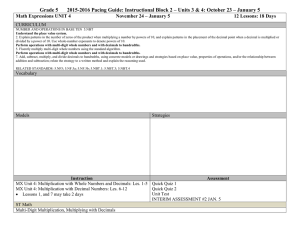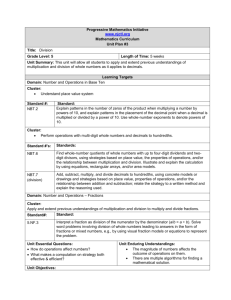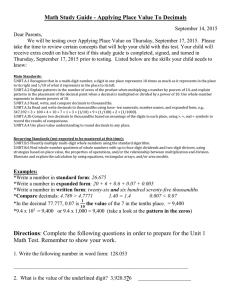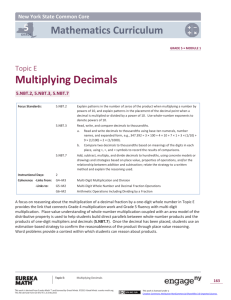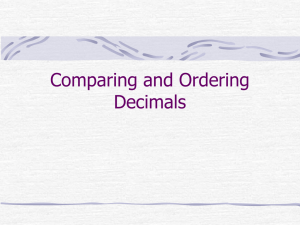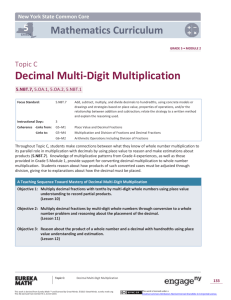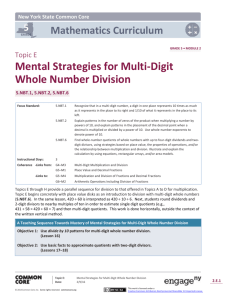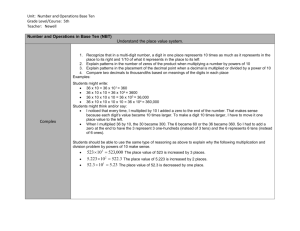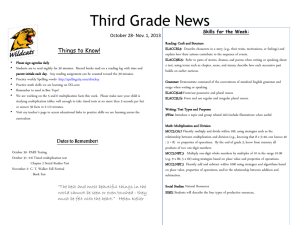5NBT multiplication division Unit plan grade 5
advertisement
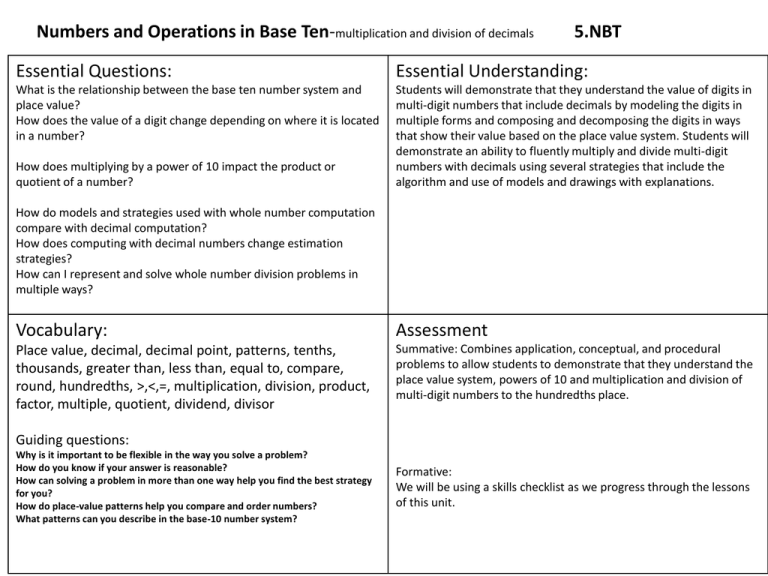
Numbers and Operations in Base Ten-multiplication and division of decimals 5.NBT Essential Questions: Essential Understanding: What is the relationship between the base ten number system and place value? How does the value of a digit change depending on where it is located in a number? Students will demonstrate that they understand the value of digits in multi-digit numbers that include decimals by modeling the digits in multiple forms and composing and decomposing the digits in ways that show their value based on the place value system. Students will demonstrate an ability to fluently multiply and divide multi-digit numbers with decimals using several strategies that include the algorithm and use of models and drawings with explanations. How does multiplying by a power of 10 impact the product or quotient of a number? How do models and strategies used with whole number computation compare with decimal computation? How does computing with decimal numbers change estimation strategies? How can I represent and solve whole number division problems in multiple ways? Vocabulary: Assessment Place value, decimal, decimal point, patterns, tenths, thousands, greater than, less than, equal to, compare, round, hundredths, >,<,=, multiplication, division, product, factor, multiple, quotient, dividend, divisor Summative: Combines application, conceptual, and procedural problems to allow students to demonstrate that they understand the place value system, powers of 10 and multiplication and division of multi-digit numbers to the hundredths place. Guiding questions: Why is it important to be flexible in the way you solve a problem? How do you know if your answer is reasonable? How can solving a problem in more than one way help you find the best strategy for you? How do place-value patterns help you compare and order numbers? What patterns can you describe in the base-10 number system? Formative: We will be using a skills checklist as we progress through the lessons of this unit. Lesson Math Concept Standard Skills Problems to Pose Anticipated Errors 1 Multiplication of Whole Numbers (multi-digit/ not assess for fluency at this time) 5.NBT.B5 • • Estimation Models/Strategi es Introduce and relate to Standard Algorithm 98 x 34 (basic problem that all students can contribute to) • Problems in context • Why does standard algorithm make sense Standard algorithm Place holders Number sense Reasonableness Double checking with other strategies Multiplication of to .01 5.NBT.5 5.NBT7 Estimation Models Number lines/multiple strategies Relating to whole number multiplication Problems in context tenths by tenths Tenths by hundredths (not hundredths by hundredths) Pg.350 from Van De Walle text Number sense with what to do with decimal Estimation Fact families Relationships between multiplication and division 4 digit dividends and 2 digit divisors Variety of strategies Problems where there is no remainder Not being solid in multiplication 2 • • • • • 3 Relating whole number division to whole number multiplication 5.NBT.6 • • • • • 4 Problems in context Pre-conceived notions of what multiplying means (doesn’t always mean getting bigger) Explanation of what division means Large numbers Double checking Lesson Math Concept Standard Skills Problems to Pose Anticipated Errors 4 Interpreting Remainders 5.NBT.6 • • Variety of Word Problems with remainders that are interpreted in different ways (round up, round down, use the remainder, turn remainder into fraction) What does the remainder mean and why? • Divisibility rules Interpreting remainders (turning remainder into fractions Problem Solving 5 Dividing with decimals up to .01 5.NBT.7 • • • • • Estimation Models Number lines Explanations Strategies (not needing to be standard algorithm) Word problems in context Smaller number with decimals What do we do with the decimal and why Explaining and using models Pre-conceived notions of division 6 Which operation to use in context 5.NBT.B5-7 • Interpret problems • Problem Solving Variety of application word problems(division, multiplication, whole number, decimals) Difference between division and multiplication (whole numbers and decimals) Why they chose their operations Computational errors
